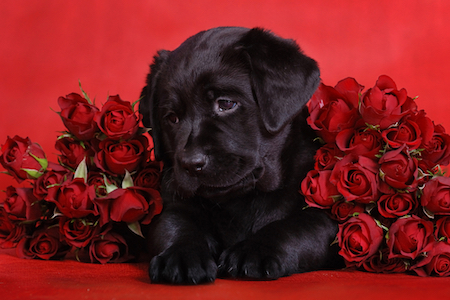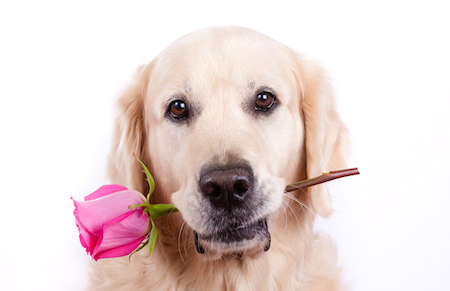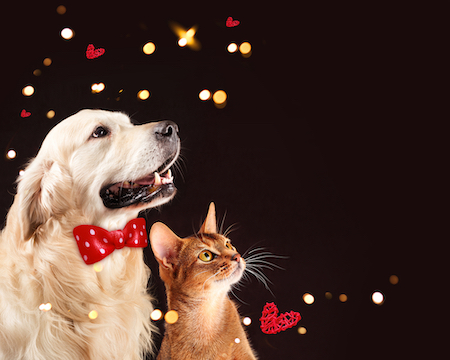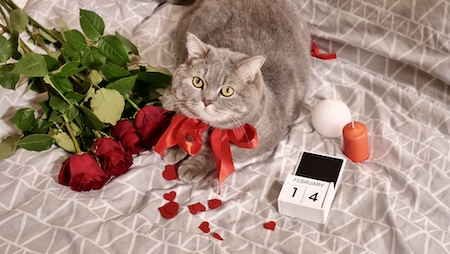Pet Insurance Review > Pet Wellness Guides > Valentine's Day Safety Tips for Pets - Pet Insurance Review
Valentine’s Day Safety Tips for Pets
Posted: 11/06/2023 | BY: Erin Cain | Categories: Uncategorized
Love is in the air! And with Valentine’s Day right around the corner, that means lots of pet owners will be celebrating their love for their furry friends, their very best valentines. But before you go overboard with the treats and gifts, make sure to keep your dog or cat’s safety in mind. Here are a few tips to help keep your pet safe and healthy this Valentine’s Day.

No chocolate or candy for your sweet furkids.
Your pet may be the cutest and sweetest of them all, but that doesn’t mean she should eat any sweets on Valentine’s Day or any other day for that matter. Although candy may seem like a tasty treat for dogs and cats, it is hazardous to their health.
Chocolate dangers
Chocolate in all forms, including baking chocolate, semisweet, milk, and dark chocolate, is dangerous and potentially lead to life-threatening situations if ingested by pets. The amount of chocolate that pets can eat without showing symptoms varies drastically based on their weight. Larger dogs may need to eat significant quantities of chocolate to show signs of toxicity. In contrast, a smaller dog may only need a nibble to result in an emergency. Generally, cats are less likely to get into chocolate than dogs. However, ingestion of chocolate is still dangerous for your feline friend, especially if they’re a curious pet.
For dogs, chocolate is toxic because it contains caffeine and theobromine. The canine body cannot break down these compounds quickly, so they end up with dangerous levels in their system. Also called methylxanthines, these two caffeine-like stimulants affect gastrointestinal, neurological, and cardiac function. The toxic substances may cause diarrhea, vomiting, or hyperactivity in dogs, as well as an abnormally elevated heart rate. In severe cases, excess chocolate consumption can cause a dog to have tremors and seizures, as well as potentially fatal respiratory failure. Lighter chocolates are no better as they are also chock full of high fat content which can cause a life-threatening inflammation of the pancreas.
Even if your dog has accidentally eaten some chocolate a few times with no apparent consequences, there are long-term fears to contend with as well. Studies show that repeated exposure to theobromine leads to cardiomyopathy. This chronic heart disease makes it harder for the heart to pump blood throughout the body. Leave chocolate away from your pets this holiday, and everyone will be safer for it.
Xylitol dangers
Some sweeteners used today in gum, baked goods, and sugar-free candies can be highly toxic to dogs and cats. Xylitol, also known as birch sugar, is one such ingredient that causes a sudden drop in blood sugar. This results in vomiting, depression, seizures, loss of coordination, and even liver failure if consumed amounts are significant enough.
Xylitol is a sweetener found in plants is used as an alternative to sugars. It is located in numerous candies and sweets, and even peanut butter in some cases. Call their vet immediately if you suspect your cat or dog has ingested something containing xylitol, such as mints, gum, or sugar-free candy. Treatment will need to begin promptly before any significant damage happens.

Carefully inspect any flower bouquets.
Many plants can harm your cat or dog if they consume the flowers or stems. Lilies, such as the Tiger Lily and Asian Showcase Plant, have been known to cause kidney failure in dogs. At the same time, roses pose risks for animals with their sharp thorns, which easily penetrate the skin, including the footpads of curious felines. Orchids also carry substantial dangers because some contain toxins. Not sure which plants are hazardous to your pet? Check out this extensive list of flowers and plants that can harm your furkid.
If you have a dog or cat, knowing the risks associated with popular bouquet flowers is essential. If your pet has ingested a toxic plant, they may experience symptoms such as drooling or vomiting. Other possible signs are diarrhea and lethargy. Should you notice any of these signs in conjunction with a lack of coordination and balance, getting your pet checked out immediately by their vet is best.
Signs of plant toxicity include seizures, difficulty breathing, and liver failure. Make sure your pet doesn’t have access to these plants at any time. Request pet-safe flowers and bouquets as a gift in the future to avoid dealing with this potentially fatal situation.

Skip balloons and beware of decorations.
It’s always a good idea to gather up tape, ribbons, and other decorations used with Valentine’s Day presents. These shiny, long, and stringy items can get lodged in your pet’s throat or digestive tract, leading to obstruction, vomiting, or choking.
Balloons should also be avoided due to their loud popping sound that may startle pets. Plus, it poses a choking hazard, too. Many animals mistake pieces of balloons for food. Balloons can cause injury, death, or deformity if they’re ingested by a dog or cat. Strings and ribbons attached to the balloon also pose a dire threat to your pet’s safety through entanglement or accidental ingestion and choking hazards.

Keep alcohol away from your pets.
It’s fun to raise a toast to the romantic ideals of Valentine’s Day, but make sure that you keep alcohol away from your pets. Even a tiny amount of alcohol can harm pets, so removing any leftover liquor out of your pet’s reach is essential. Although most pets dislike the taste of alcoholic drinks, all it takes is an open bottle or glass, and a curious pet laps the liquid up. A dog or cat who has had alcohol may exhibit signs of vomiting, diarrhea, and a lack of balance and coordination. Central nervous system depression can lead to respiratory failure, threatening your pet’s life.
Some people may not realize that even though animals won’t be likely to take more than one sip of your drink, certain mixed drinks or alcohol-based cakes can appeal to them. In addition, these ingredients, such as chocolate, grapes, raisins, and macadamia nuts, are dangerous to pets if eaten by them.

Blow out those romantic candles.
Candlelight is a beautiful way to set the romantic mood for your Valentine’s Day holiday. When it comes to your pets, though, it’s essential to not leave unattended candles burning at any time; the same rule applies to fireplaces. Curious and bored kittens and dogs can get too close to these heat sources, which may cause them harm or start a house fire by knocking over unattended, lit candles.
Additionally, consideration must be given to the scent of candles when purchasing them for your home or holiday. Some smells, including those with essential oils, can be overpowering for your pet. They may even create a respiratory risk in pets with more sensitive airways, making it evident that they are uncomfortable or having trouble breathing.
LED candles are a perfect choice if you’re looking for a safer alternative that still provides a more natural or traditional look. They offer an authentic flickering flame that will fill your home with warm light any time of year. Follow these Valentine’s Day safety tips for a safe and happy holiday.
Accidents happen, even on Valentine’s Day.
No matter what time of year, companion animals can experience an accident or injury. Instead of panicking about what to do, where to go, and how you will afford the unexpected expense, choose to be like those pet parents who have a pet insurance plan for their furkid.
A pet health insurance policy will ensure your dog or cat’s treatment is covered at your veterinarian’s office or local veterinary emergency clinic. Most insurance providers offer plans with up to 90% cost coverage. This plan saves pet parents from paying high vet bills and dealing with more stress on top of an already difficult situation. Pet Insurance Review has the best plans made available by the top insurance providers. Don’t wait to get a free quote for your pet and give her the gift of the best Happy Valentine’s Day ever.
References:
1. Pet Poison Hotline. (2022). Chocolate Toxicity to Pets. Retrieved from https://www.petpoisonhelpline.com/poison/chocolate/
2. McVean, A. (2019). My Dog Ate Chocolate and He Was Fine, so What’s the Big Deal? Retrieved from https://www.mcgill.ca/oss/article/health/my-dog-ate-chocolate-and-he-was-fine-so-whats-big-deal
3. Clemmett, B. (2021). Theobromine: It’s in Chocolate and It’s Bad for Your Pet. Retrieved from https://www.readivet.com/theobromine-it-s-in-chocolate-and-it-s-bad-for-your-pet
4. Weingart, C., Hartmann, A., Kohn, B. (2021). Chocolate ingestion in dogs: 156 events (2015 – 2019). Retrieved from https://onlinelibrary.wiley.com/doi/full/10.1111/jsap.13329
5. Brooks, W. (2021). Chocolate Toxicity in Dogs. Retrieved from https://veterinarypartner.vin.com/default.aspx?pid=19239&id=4952115
6. U.S. Food & Drug Administration. (2021). Paws Off Xylitol; It’s Dangerous for Dogs. Retrieved from https://www.fda.gov/consumers/consumer-updates/paws-xylitol-its-dangerous-dogs
7. ASPCA. (2020). Mother’s Day Bouquets: What’s Safe for Pets? Retrieved from https://www.aspca.org/news/mothers-day-bouquets-whats-safe-pets
8. Lohmeyer-Mauzy, C. (n.d.). Toxicology Brief: Ethanol Toxicosis in Dogs. Retrieved from https://www.vetfolio.com/learn/article/toxicology-brief-ethanol-toxicosis-in-dogs
DisclaimerThe information contained on this blog is intended for informational and educational purposes only and should not be construed as medical advice. It is not a substitute for professional veterinary care. Always consult with your veterinarian before making any changes to your pet's health care or treatment plan.
The authors of this blog are not veterinarians and do not claim to be experts in pet health. The information provided here is based on our own experiences and research, as well as information from reputable sources. However, we cannot guarantee the accuracy or completeness of this information.
We encourage you to do your own research and consult with your veterinarian before making any decisions about your pet's health.